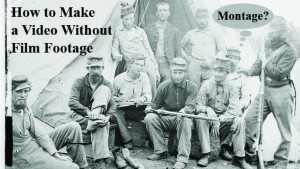 A commenter recently took me to task for using a blog post title that was misleading. The post, which was one of my first on this blog (August 2012!!), described a film editing technique called “montage” in which the filmmaker uses a series of still images instead of footage to tell a story in a video. The title of the post was “How to Make a Science Video Without Film Footage”. The commenter said that I failed to tell how to do it, what software to use, or to provide a tutorial. Therefore, my post was “wrongly named”.
A commenter recently took me to task for using a blog post title that was misleading. The post, which was one of my first on this blog (August 2012!!), described a film editing technique called “montage” in which the filmmaker uses a series of still images instead of footage to tell a story in a video. The title of the post was “How to Make a Science Video Without Film Footage”. The commenter said that I failed to tell how to do it, what software to use, or to provide a tutorial. Therefore, my post was “wrongly named”.
My intent with that post was to encourage budding scientist videographers, who have no video footage but do have lots of photographs depicting their research, to go ahead and make a video with whatever media they have in hand. I described how someone in this situation could still create an effective video with a sequence of photos and included a video example that primarily used still images to produce a narrative. I also described how one might use the “Ken Burns” effect to add motion to photographs and also sound effects (birds or crickets chirping, water sounds), all of which add to the illusion of movement in the montage.
My plan was to do a follow-up post and tutorial to demonstrate how to implement the montage technique….but I never got around to it.
The comment, though, told me that people were searching for tutorials showing how to make a video without film footage. So in this post, I would like to offer a tutorial that shows step by step how to edit still images to create a video. As you will see, I provide instructions on how to import photos, how to add a “Ken Burns effect”, how to add transitions between photos, how to add text titles, and how to add music or sound effects to bring the montage to life. Although I used iMovie (Version 10.0.8) for this tutorial, the principles of the montage technique generally apply to other editing software.
Note: This tutorial assumes that the viewer is familiar with the basic editing tools in the iMovie application (or some other editing software). However, you don’t need a lot of editing experience to apply this technique. In fact, montage is perhaps the easiest technique for a novice videographer to use when first starting to make videos.
Be sure to select the HD version (1080p) and full screen for best viewing (direct link to the video on YouTube):



